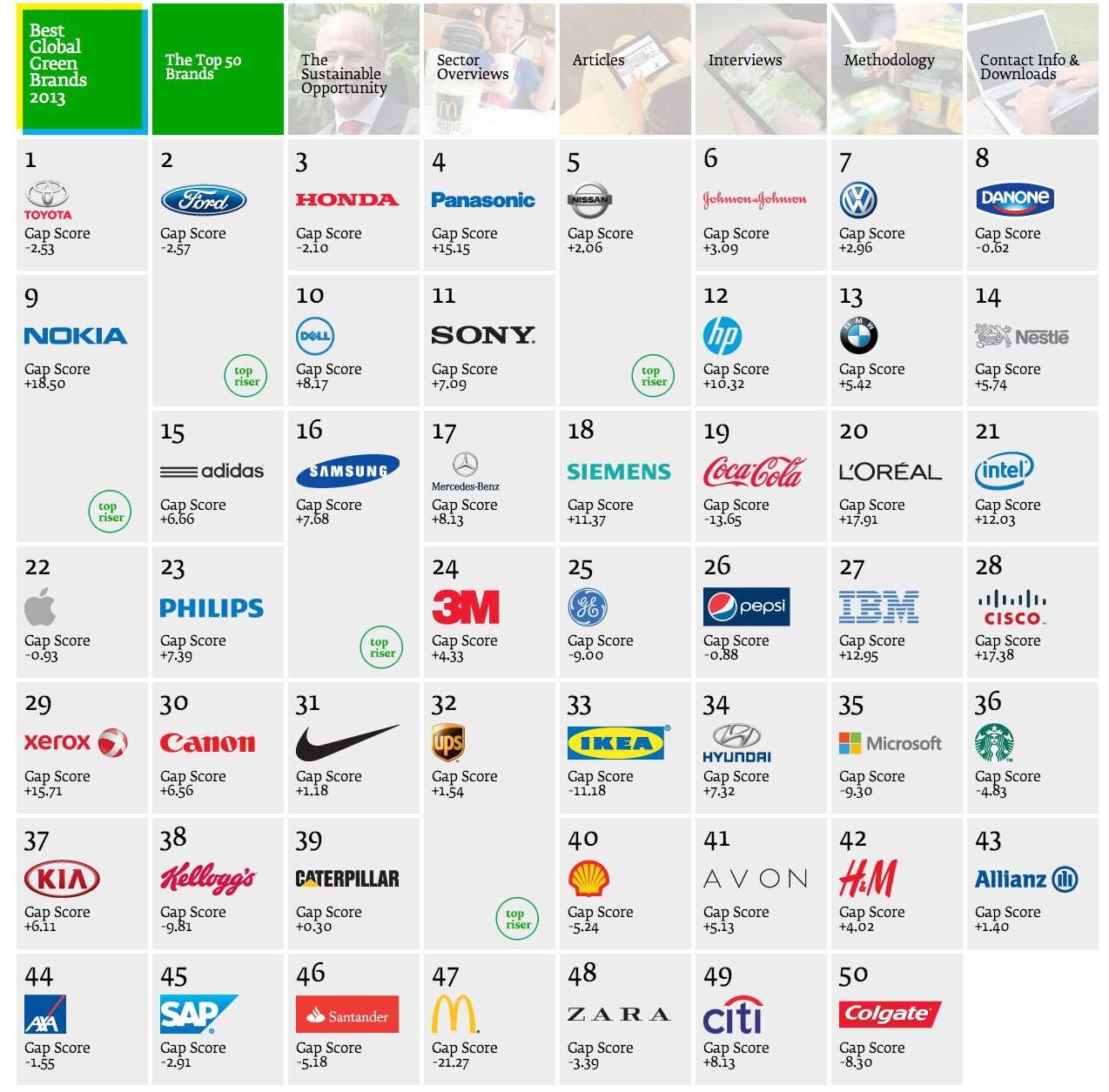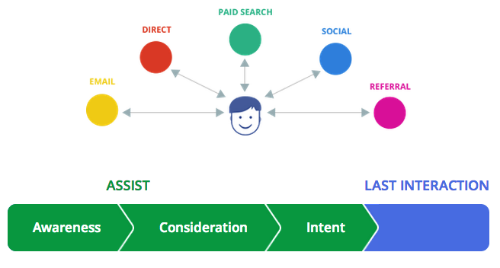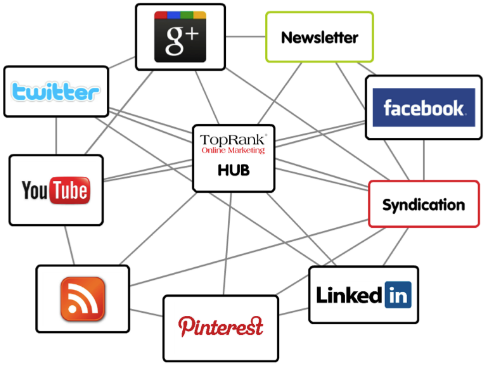~Affordable Youtube Video Advertising~
Entertainment, Websites, Social Media, Internet Marketing and Entrepreneurship.
ShareThis
Tuesday, August 13, 2013
Branding: Color Emotion Guide
~Affordable Youtube Video Advertising~
Saturday, August 3, 2013
Marketing: Global Green Brands of 2013
This is really interesting viewing/reading if you are interested in what brands/companies are doing their bit for our environment. Interbrand have created this dynamic Top 50 list that allows you to see information relative to each brand, and their commitment to adopting 'greener' technologies and work practices.
Specifically, it's about sustainability: defined as an ongoing effort to improves the quaity of human life while living within the limits of supporting ecosystems.
For Interbrands top Top 50 Global Green Brands of 2013, sustainability is defined as: "…business approach to creating long-term value by embracing opportunities and managing risks derived from economic, environmental, and social impacts. In a commercial sense, sustainability also involves creating and maintaining a product, service, or business identity that reflects special added value in terms of environmental and social benefits. Sustainability has proven to be a strategic and profitable aspect of business and a brand-strengthening asset, as long as organizations take measurable steps to reduce their social and environmental impact and credibly convey benefits that are relevant to consumers."It's definitely worth checking the first row of boxes as these provide essential information that allows you to put the results all into context.
Source
Friday, August 2, 2013
Online Marketing Blog - 7 Ways Small Businesses Can Integrate SEO, Social Media & Content Marketing
Online Marketing Blog
Online Marketing Blog - 7 Ways Small Businesses Can Integrate SEO, Social Media & Content Marketing
In today's age of ubiquitous connectivity, many small businesses have implemented a variety of online marketing efforts to attract new customers and increase overall sales. Unfortunately, results can vary significantly because tools are only as good as the expertise of the person using them.
The lure of the "next big thing" can create online marketing inefficiencies when small business owners try to be a marketing "jack of all trades and master to none".
For example, the rapid growth and adoption of the social web can be overwhelming for small business marketers. Consider these social network growth statistics:
Small business owners, employees and their customers use various social networking sites personally so in many cases the platforms are familiar. As a result, more small business marketers are starting to use Facebook, Pinterest and Twitter to attract new customers and engage those customers they already have.
- Google sites handle about 100 billion searches each month (SEL)
- YouTube hosts nearly 14 billion videos (comScore)
- Facebook is now over 1 billion users (Mark Zuckerberg)
- Google+ has over 500 million users (Google)
- Twitter has over 550 million accounts (Statistics Brain)
- LinkedIn is at 225 million users (LinkedIn)
- Pinterest grew 4,377% in 2012 and continues to expand with 25 million users (TechCrunch)
However, personal use is not the same as expertise when it comes to marketing and with so many options available, prioritization, management and optimization are less than ideal.
Essential Questions for Small Business Marketers:
The variety of options for customer marketing and engagement ranging from social media to SEO to email marketing to online advertising can be overwhelming. As a result, some of the most common online marketing questions I hear from small businesses revolve around how to decide which tactics are best? Or, "How to manage time across so many tactics? and "How long will it take to see results?"
Answering these questions starts with a clear understanding of goals, customers and a flexible online marketing strategy that assembles the right mix of tactics and measurement practices. Most companies are looking for more customers and to retain those they have, but the question is, "How to do so efficiently?"
The Answer for Better Online Marketing Starts with Content:
In the context of this article, a big part of the answer is through content marketing. If Social Media and SEO fit together like peanut butter and jelly (if you didn't know, yes they do) then content is the bread that holds them together.
For 81% of consumers, search influences what they think about a company (Weber Shandwick) and of companies that invest in content marketing, 78% use paid search and 69% use SEO to increase audience discovery of that content (Outbrain) – eMarketer.
The trend in search and social information discovery, consumption and action behaviors of consumers are an opportunity for small businesses in all industries to become highly valued sources of information wherever their customers are looking.
Search engines favor high value content in the search results. Social media sites favor sharable, linkable content. A small business that combines smart Social Media and SEO tactics can create a competitive advantage for attracting new customers whether they search Google, Facebook, YouTube, Twitter or blogs.
Topics and Keywords Homework:
With search or social media optimization, it's important to empathize with the audience you're trying to reach in terms of the language they use while searching and how they talk on the social web.
Optimizing a web site for topics and specific phrases that customers rarely use, results in a waste of effort on your part and frustration on the part of the customer because they can't easily find your content.
Keywords from a social media perspective involve discovering what customers are interested in and talking about on the social web vs. deciding that for them by pushing traditional marketing materials.
Basic Search Engine keyword research can be done with free tools available from Google.
Enter the kinds of phrases that your customers use and the Google Keyword Tool will report back the popularity of those phrases and suggest related phrases to target. The process of doing keyword research should result in the creation of a keyword glossary, which is a list of keyword phrases in a spreadsheet.
Whenever new content is created online, the keyword glossary can be referenced to check keyword relevance and popularity so new information published to the web is of interest to customers that are searching. The process of looking up keywords to determine current popularity and variations should be repeated quarterly to stay current.
Social keyword research is a little trickier because there are no dedicated tools to provide what topics and phrases are most popular on the social web at large. However, there are tools like SocialMention that offer a social search function which provides a list of keywords most often found in Tweets, comments and other social content based on your query. The keywords can be imported into your Keyword Glossary spreadsheet for comparison to search keywords.
Social keywords might help you determine topics for Tweets, Facebook updates and content, tags used with videos and images, blog posts and general names/titles of content and objects that you publish using social media websites. Doing so helps guide content that is of interest to those publishing similar content on the social web.
Quick Tip: Your brand name is a keyword and worth protecting. Check your brand name with a site like Knowem to make sure no one else is squatting on it. You can register accounts yourself or have the folks at Knowem do it for you.Proven tactics to win the online marketing race:
I say race, because in the online world, that's exactly what it is. A continuous effort towards achieving marketing goals while the competition is doing the same thing. That might seem ominous, but think of it as something you spend a reasonable, scheduled amount of time on consistently. If you keep at it, and work smart, you will win.
Here are 7 content marketing tactics that small businesses can use in combination with SEO and Social Media to win and keep more customers.
1. Blog
A blog offers numerous social and SEO benefits. Blogs are very effective as the hub in a "hub and spoke" social media content model. The spokes of that model might be Twitter, Google+, Facebook, Pinterest, YouTube, Foursquare and other social media sites your customers are participating on.
Blog posts can focus on answering Frequently Asked Questions and topics of interest to customers. Create categories for each area of focus in your business to serve as an editorial guide.
Schedule posts in advance to save time and encourage staff to comment and promote the blog on any other social sites you're involved with.
You can find many "how to" articles here in our blogging category.
2. Newsletters & Email Marketing
Email newsletters are great ways to connect directly with prospective customers offering tips and other content. A newsletter for existing customers helps reinforce the connection you have with them and can encourage referrals. A single newsletter can meet the needs of both lists with basic segmentation functionality and personalization features.
When publishing content on other social sites like Facebook, your blog or Twitter, readers can be invited to sign up for your newsletter where they can learn more about your business.
3. Media Coverage & Contributed Articles
Getting mentioned in the local business media and trade publications can boost awareness, credibility and directly generate new business.
To help make that happen, make a list of local business publications, writers and editors as well as popular bloggers. Inquire with those websites about contributed articles or guest blog posts. Content off of your own site gives you exposure to a new audience and links from the author bio back to your website.
Visit industry blogs and make comments that add value, then follow up with more detailed, useful information. Provide "hooks" that give perspectives and insights not normally thought of. Stand out and tell a compelling story. Follow up but don't stalk!
Many of the relationships we have at TopRank Online Marketing with journalists came as a result of sending an email offering 1-3 abstracts for potential contributed articles. Now many of those news sites contact us for quotes.
4. Resource Center
One way small businesses are beating their larger competitors in search and in building authority is to be a better resource for customers through useful content. Common formats for helpful information about buying, using and related information on products and services include articles, videos and podcasts. Think of it as an online encyclopedia for content and topics related to your business.
Again, this is something you can build up little by little over time. Writing tasks can be handled by internal staff, outsourced bloggers and copywriters.
An effective resource center will be keyword optimized, easy to share on social media site using embedded sharing widgets like Share This and attract links from other websites. Keywords + useful content + links = search engine dominance.
5. Social Networks & Media
In the way that customers expect a toll free number, web site and blog, they're beginning to expect the businesses they engage with to be social. That means having a presence in the social networks that are most relevant to customers. Spending a small amount of time consistently on interaction and relationship building can go a long way towards developing a community.
The key is picking the right platform. It might be a LinkedIn group, Facebook Fan page or a niche forum. Try out a social media monitoring tool like Bottlenose, or social search tools like Topsy to get an idea of which social websites might be good places to engage with potential customers.
Don't be afraid to repurpose content. What you create on the newsletter, blog and resource center can be modified and cross-promoted with social networking and media sharing sites.
6. Local and Mobile Content
While "fish where the fish are" ranks as one of the most over-used cliché's in the marketing world, it's important to recognize consumer trends towards mobile search with the proliferation of smart phones and tablet devices like the iPad. The web experience has definitively extended beyond the personal computer and marketers must understand their customers' use of mobile search and what the marketing opportunities are.
Make sure your website can be viewed properly on mobile devices and if you see a significant amount of traffic to your site (via web analytics) from mobile, then you might consider creating a mobile friendly version.
This tool can check the mobile friendliness of your site. Keep in mind, it doesn't need to be completely compliant to be useful to customers on their mobile phones, but Google has mentioned recently that mobile sites with technical issues will not rank as well as those that are optimized. Also, most smart phones like an iPhone or Android can view websites the same as you would on a computer.
From a local perspective, for companies that serve customers in specific regions or with geographically specific needs, its essential those businesses are present in local search results, map results and specific geo-location queries. That means making sure your business is properly listed with Google Places for Business, Yahoo Local, and Bing Places for Business listings.
Be sure you take advantage of the opportunity to add content to local listings. In the case of Google and Bing Places, you can add images, video and description content that will make your business stand out. To begin optimizing your local presence, check out Get Listed.
7. Video
If a picture is worth a thousand words, then a video is worth millions. A video highlighting your business on a YouTube channel can be helpful for customers in getting "to know" who they might be seeing.
Videos can also be used to demonstrate products, show customer testimonials and highlight the personality of staff working within the small business. Videos hosted on sites like YouTube can be embedded within blog posts, extending their value as content.
Conclusion:
As a small business, should you do all of these things? No, of course not. Wearing many hats and slim resources means all of these tactics won't be practical. But you can start small and specific. Then grow and adapt with more or different content according to what's working vs. what's not. Just be sure to gain an understanding of what your customer's information needs are, what topics and keywords are important to them and then optimize, socialize and publicize that content so your small business becomes the "best answer" for customers at the moment they need you most.
Thursday, August 1, 2013
Networking: Online Class
Here is the link
Networking is essential to the success of any business, no matter how big or small. But how do you know you’re making the right connections to grow your business? Join Porter Gale, author of Your Network Is Your Net Worth, right now as she kicks off her two-day workshop covering everything you need to know to effectively and efficiently expand your network.
Subscribe to:
Posts (Atom)





